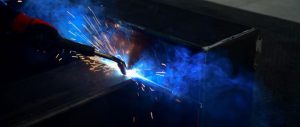The gas metal arc welding (GMAW) process, also known as MIG welding, is susceptible to various types of weld discontinuities or defects. This article outlines some of the frequently encountered issues.
Excess Reinforcement Buildup
When welding a joint from one side, the root side can experience a buildup of excess reinforcement or weld metal. In GMAW, this melt-through condition may occur due to the high heat input and deep-penetrating arc. While some reinforcement is typically acceptable, an excessive amount can lead to poor bead contour and potential for cracking.
Heat-Affected Zone Cracking
Cracking in the heat-affected zone (HAZ) of the base metal near the weld fusion line is often associated with hardenable steels. However, this defect is not specifically caused by or unique to the GMAW process when compared to other arc welding methods.
Lack of Fusion
The short-circuit transfer mode used in GMAW involves lower heat input, minimizing melting of the base material. This is beneficial for thin sections and out-of-position welds. However, improper technique can still result in areas of incomplete fusion between the weld and parent metal, especially in root areas or along joint grooves. Poor arc aim during spray transfer can also contribute to lack of fusion.
Incomplete Root Penetration
In groove welds, incomplete root penetration refers to areas where the weld metal fails to extend fully through the joint thickness on the root side.
Weld Porosity
Porosity defects appear as cavity-type discontinuities within the weld metal caused by entrapped gas during solidification. The cavities may contain various gases like oxygen, nitrogen, hydrogen or even shielding gas. GMAW’s reliance on shielding gas coverage makes it more prone to porosity compared to other welding processes that use flux.
Undercut Defects
Undercut appears as an unfilled groove or channel melted into the base metal adjacent to the weld toe or root. The high fluidity of the GMAW weld pool coupled with rapid travel speeds can increase susceptibility to undercut if proper techniques are not followed.
Weld Metal Cracking
Cracking within the deposited weld metal itself represents one of the most serious defects. These cracks are heavily influenced by the existing metallurgical conditions and composition of the material being welded. While not directly caused by GMAW, certain practices with this process can potentially contribute to weld metal cracking.
Appropriate quality control and following proper welding procedures are essential to minimize the occurrence of discontinuities and ensure sound GMAW weld integrity.
source: www.aws.org

